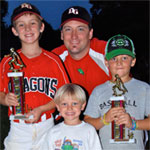Defensive Strategy and Player Positioning
Baseball defensive strategy has more to it than where to position your infielders and outfielders. A coach knowing strategies for defensive situations is key to proper defense. Positioning fielders may be the difference between an out and a RBI triple. Defending a bunt correctly may keep you out of a big inning. Your coaching strategy for infield defense and anticipating your opponents offensive strategy may be the key to staying out of the big inning.
#1 Standard Infield Positioning
Against right handed batters, the infield will be in a "straight up" position. Middle infielders will play even depth and will more or less position themselves about half way between their respected bases. The "corners" ( first & third baseman) may take positions just behind or just in front of their respected bases based on a number of factors including advanced scouting, comfort, game situation, etc. Against left handed batters, the infield will shift to the right with the first baseman playing the line and behind first base. How much the other infielders shift over will also depend on a number of factors that were just mentioned.
Get dozens of practice plans and over 200 baseball drills!
#2 Defending the Bunt
Typical defense against a bunt will include but will not be limited too bringing the corners in to play in front of the bases and on the infield grass. The middle infielders may play back and that will be based on the game situation. If the batter is suspected of just being up to bunt or it is blatant that the only intent is to bunt then the middle infielders should also come in on the infield grass. In a sacrifice bunting situation, one defensive strategy is to utilize the wheel play in attempt to throw out the lead runner on a bunt.
#3 Bringing the Infield In
If the game winning run is on third base then the infield will all play in on the infield grass. This will give them the best chance to cut down the runner at home or at least hold the runner at third. This strategy can also be used if the coach feels the game is tight, runs are few, and it is more important to stop the run from scoring then anything else. With the bases loaded or first and third, a coach may chose to just bring in the "corners" but keep the middle infielders back to keep the chance of a double play alive as well. Variations of this strategy will always depend on game situations and sometimes even coach's intuition.
#4 Defending the Stolen Base
The straight steal is a pretty simple concept to plan to defend against. It is simply the catcher and the infielder applying the tag vs the base runner. On the other hand, when there is more than one base runner then the stolen base works as an offensive strategy that may take a little more thought to defend. A very common theme in Little League games is for an attempted steal of second base while there is also a runner occupying third base. There are several different strategies that can be used and some that involve so called "trick plays". I find that maybe the safest most effective thing that a defense can do against this is using the simple "pump fake" to possibly draw the runner off third for a pick off attempt. The "pump fake" can be used by the catcher who can "pump fake" a throw to second base or the catcher can quickly get the ball back to the pitcher who can use the "pump fake" to second base. Another type of steal that can be problematic for a defense is the double steal of second base and third base. If the batter fakes a bunt attempt this will draw in the corners and at the same time could leave third base, second base, or even both bases undefended which presents a great opportunity for a double steal. The best way to defend this is to simply make sure all infielders are aware of their assignments for this situation to ensure all bases that are in jeopardy are defended.
#5 Playing With a 5 or More Run Lead
When playing with a big lead, the infield should take any easy out that is being handed to them by the offense and absolutely trade runs for outs. This concept is especially true late in games. For example, when a team is down to it's final six outs and the lead is 5 or more, any ball hit to the pitcher should be going to first base with the exception of a force play at home. Why? The shortest most uncomplicated plays will be to first base unless the pitcher has the chance for an easy force play at home. Remember,when a team is down by 5 or more runs, every out that is made by the defense will put that much more pressure on the offense.

